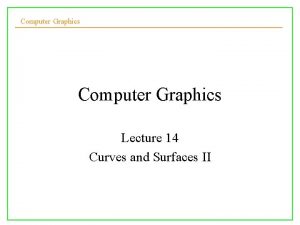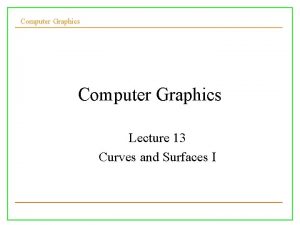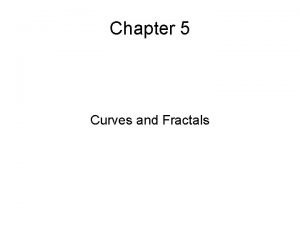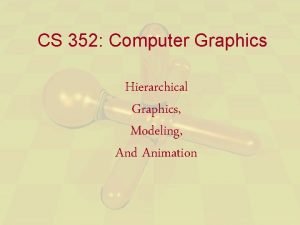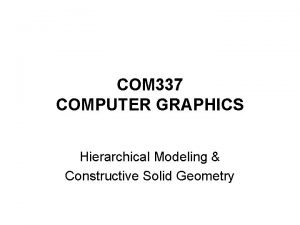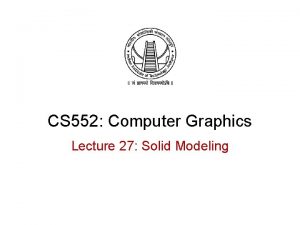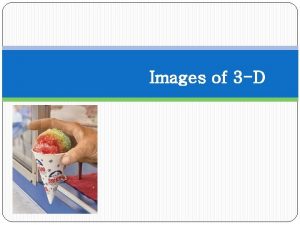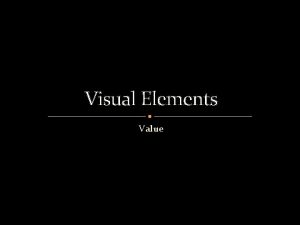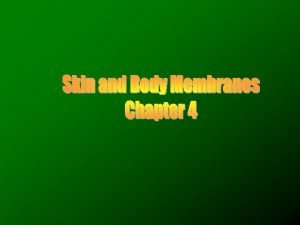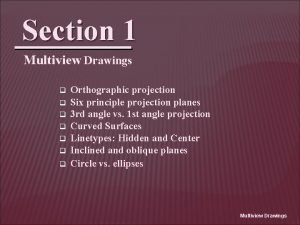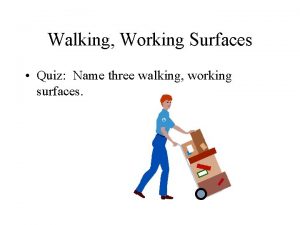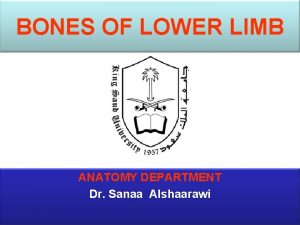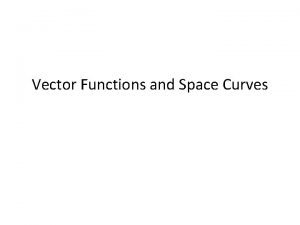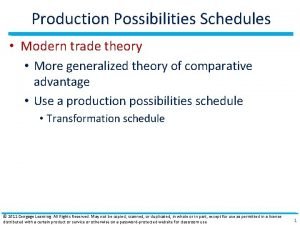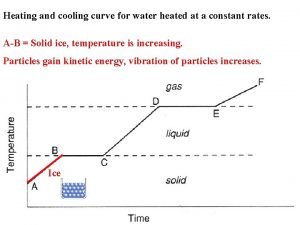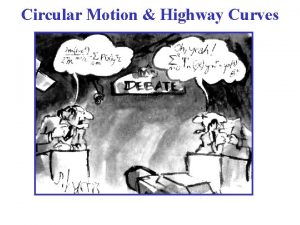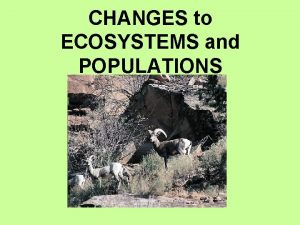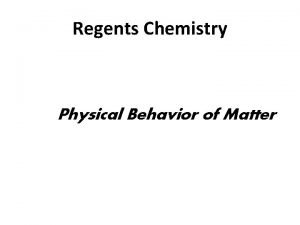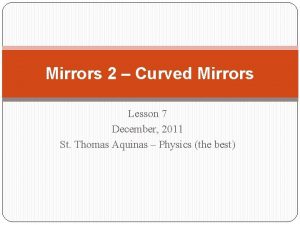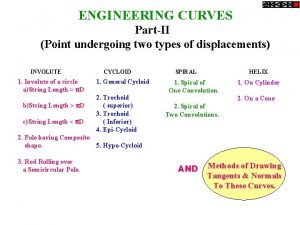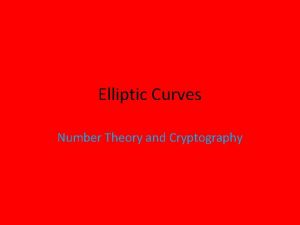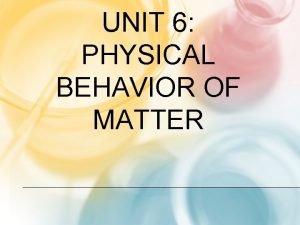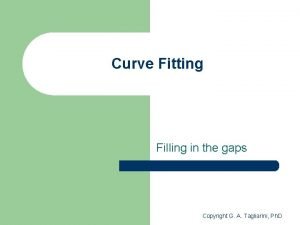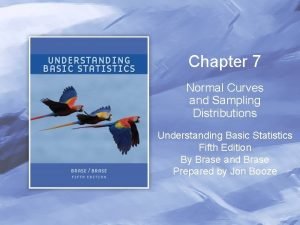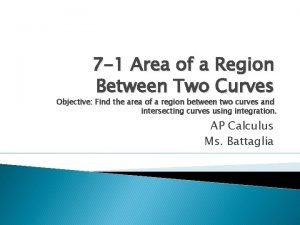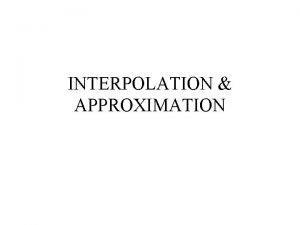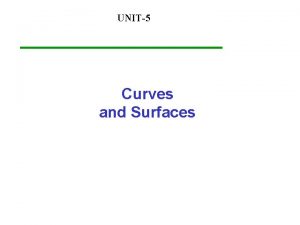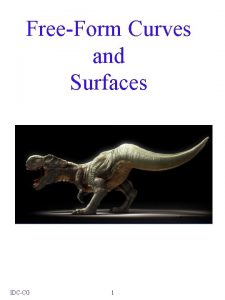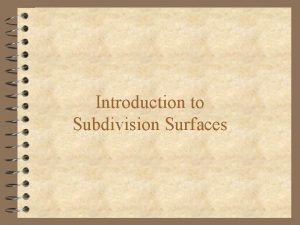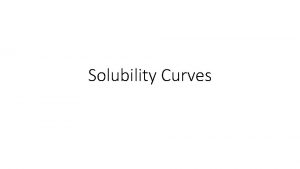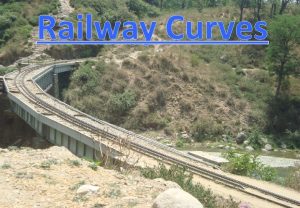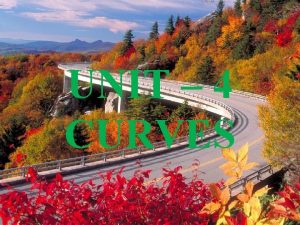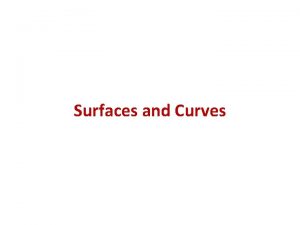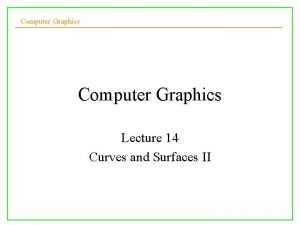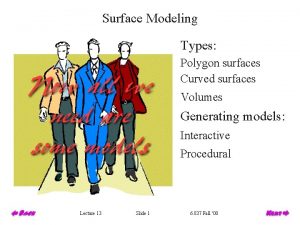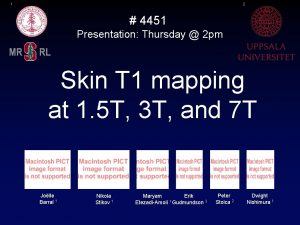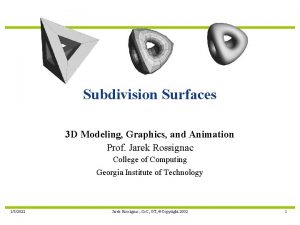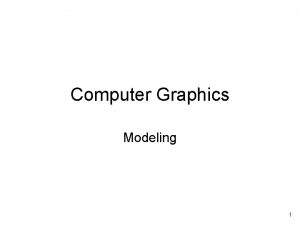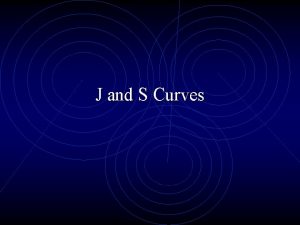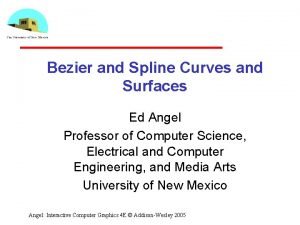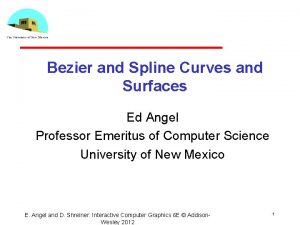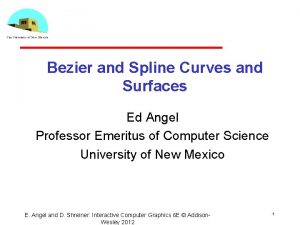Curves and surfaces 4451 3 D Modeling Graphics








































- Slides: 40

Curves and surfaces 4451 3 D Modeling, Graphics, and Animation Prof. Jarek Rossignac College of Computing Georgia Institute of Technology 12/31/2021 Jarek Rossignac, Co. C, GT, ©Copyright 2002 1

Lecture Objectives • Learn (by heart) the Split&Tweak and the 4 -point subdivision rules for polygons • Be able to discuss their advantages and drawbacks • Be able to design a trivial algorithm for these schemes • Understand how to construct good bounds (in 2 D and in 3 D) around the final curve from one of its approximations • Understand how to use these subdivisions to define tessellations (quads or triangles) of smooth surfaces in 3 D • Be able to design the surface subdivision schemes • Understand the benefits of having a parametric polynomial form for the curves and surfaces 12/31/2021 Jarek Rossignac, Co. C, GT, ©Copyright 2002 2

Motivation • Smooth curves and surfaces are used for aesthetic, manufacturing, and analysis applications where discontinuities due to triangulated approximations would create misleading artifacts. • Designers like to specify such curves by adjusting a control polygon with only a few vertices • How to go from a crude control polygon (black) to a smooth curve (red)? • Suggestions? 12/31/2021 Jarek Rossignac, Co. C, GT, ©Copyright 2002 3

Split&tweak B-spline subdivision • Given a control polygon, for example (a, b, c, d), repeat the following sequence of two steps, until all consecutive 4 -tuples of control points are nearly co-linear. 1. “Split”: insert a new control point in the middle of each edge (2, 4, 6, 8) 2. “Tweak”: move the old control points half-way towards the average of their new neighbors (1, 3, 5, 7) • The control polygon converges rapidly to a smooth curve, which happens to be a cubic B-spline curve. 2 a b 3 1 4 8 5 7 d 12/31/2021 6 c Jarek Rossignac, Co. C, GT, ©Copyright 2002 4

My first Split&Tweak in Scheme • • • • (define w 200) (define s 10) (define (draw-p-to-p p 1 p 2 col) (draw-solid-line (make-posn (+ (* (/ w s) (posn-x p 1)) w) (- w (* (/ w s) (posn-y p 1)))) (make-posn (+ (* (/ w s) (posn-x p 2)) w) (- w (* (/ w s) (posn-y p 2)))) col)) (define (draw-port col) (begin (start (* 2 w)) )) (define (last w)(cond [ (empty? (rest w)) (first w)][else (last (rest w))] )) (define (mid a b) (make-posn (/ (+ (posn-x a) (posn-x b)) 2) (/ (+ (posn-y a) (posn-y b)) 2))) (define (refine q r) (cond [(empty? (rest q)) (cons (first q) (cons (mid (first r) (first q)) empty))] [true (cons (first q) (cons (mid (first q) (first (rest q))) (refine (rest q) r))) ])) (define (subdivide q n color) (cond [(= n 0) (draws q color)] [else (subdivide (tweaks (tweakh (refine q q ))) (- n 1) color)])) (define (tweaks q) (cons (first q) (tweak (rest q)))) (define (tweak q) (cond [(or (empty? (rest q)))) q] [else (cons (first q) (cons (mid (first (rest q)) (mid (first q) (first (rest q))) ) (tweak (rest q) ))) )] )) (define (tweakh r) (cons (mid (first r) (mid (first (rest r)) (last r))) (rest r))) (define (draws q color) (draw q q color)) (define (draw q r color) (cond [(empty? (rest q)) (draw-p-to-p (first r) (last r) color) ] [else (and (draw-p-to-p (first q) (first (rest q)) color) (draw (rest q) r color) )])) (define p (list (make-posn -8 8) (make-posn 8 -8) )) (draw-port 'yellow) (draws p 'black) (subdivide p 1 'red) (subdivide p 2 'green) (subdivide p 4 'blue) 12/31/2021 Jarek Rossignac, Co. C, GT, ©Copyright 2002 5

Examples from my Split&Tweak program 12/31/2021 Jarek Rossignac, Co. C, GT, ©Copyright 2002 6

Yang’s version in Mat. Lab • • • function result = Sub_divide (P, color, width); [m, N] = size (P); P = [P, P(: , 1)]; % make it closed loop result = zeros (m, 2*N); even = [2: 2: 2*N]; odd = [1: 2: 2*N-1]; prev = [1: N]; next = [2: N+1]; result(: , even) = 0. 5 * (P(: , prev) + P(: , next)); • prev = [2*N, 2: 2: 2*N-2]; next = [2: 2: 2*N]; • result(: , odd) = 0. 5 * (result(: , prev) + result(: , next)); • result(: , odd) = 0. 5 * (result(: , odd) + P(: , 1: N)); 12/31/2021 Jarek Rossignac, Co. C, GT, ©Copyright 2002 7

Implement your own version • • • Try for the most elegant and shortest (not the fastest) Start with an array V of n vertices of a closed polygon P in 2 D Write a procedure SHOW(V) that renders P Make another array M of n midpoints of edges of P Make a third array A, where each vertex of V is moved by 1/4 towards its neighbors in V • Display the polygons of V, M and A to verify your program • Make an array S of 2 n vertices by interleaving A and M – {A[0], M[0], A[1], M[1], A[2], M[2]…A[n], M[n]} • Display polygon of S and of V in different colors to check • Make a procedure BSPLINE(V) that takes V and returns S • SHOW(BSPLINE(BSPINE(V))))… 12/31/2021 Jarek Rossignac, Co. C, GT, ©Copyright 2002 8

Inspiration • Check previous year projects with examples and sourcew code • http: //www. cc. gatech. edu/classes/AY 2003/cs 4451 b_fall/p 1 examples. htm 12/31/2021 Jarek Rossignac, Co. C, GT, ©Copyright 2002 9

Can the limit curve self-intersect? • Can it self-intersect when P does not? 12/31/2021 Jarek Rossignac, Co. C, GT, ©Copyright 2002 10

Where do the control vertices converge to? • The original control vertex b converges to b’=(a+4 b+c)/6 • The tangent at b’ to the B-spline curve is parallel to ac b a 12/31/2021 Jarek Rossignac, Co. C, GT, ©Copyright 2002 b’ c 11

Local control for B-spline curves • Trace the original vertices during subdivision – Do they move along straight lines? • • They subdivide the final curve into spans Each span is influenced by 4 control vertices Each control vertex influences 4 spans Each span converges to a cubic Bezier curve • The coordinates of C(t) are cubic polynomials in t b d b’ a 12/31/2021 d’ e Jarek Rossignac, Co. C, GT, ©Copyright 2002 12

Each span is a cubic polynomial • A polynomial formulation is available for each span – C(t)= B 0(t)P 0+ B 1(t)P 1+ B 2(t)P 2+ B 3(t)P 3 • Bi are cubic polynomials in t • Pi are control points easily derived from a, b, d, e b a b 12/31/2021 c d b’ a P 0 P 1 d’ e Jarek Rossignac, Co. C, GT, ©Copyright 2002 13

Convex hull • Each span lies in the convex hull of 4 original vertices – The two from which its end-points evolved – Their immediate neighbors on each side • The convex hull of 4 points in 3 D? – A tetrahedron • The convex hull of 4 points in 2 D? – Covered by 3 triangles: ABD, ABE, BDE B D B’ A 12/31/2021 D’ E Jarek Rossignac, Co. C, GT, ©Copyright 2002 14

How can we use the convex hull property? • Display uncertainty (region guaranteed to contain the limit curve) – Shade triangles (in 2 D) or tetrahedra (in 3 D) • Decide when to stop the subdivision – All triangles or tetrahedra are nearly linear • Quickly decide when two B-spline curves in 2 D are not intersecting – The convex hulls do not overlap 12/31/2021 Jarek Rossignac, Co. C, GT, ©Copyright 2002 15

Open curves • If you want to subdivide an open polygon – – Trace the original vertices through the subdivision process They split the curve into spans (bent versions of the original edges) v 0 should not influence the head (beginning of the curve) vn– 1 should not influence the tail (end) v 1 v 2 v 0 vn-1 vn-2 12/31/2021 Jarek Rossignac, Co. C, GT, ©Copyright 2002 16

4 -point subdivision • The B-spline subdivision produces a curve that does not interpolate the vertices of the original polygon P • To obtain an interpolating subdivision rule, we must leave the original vertices of P where they are, and thus must displace the mid-points. • By how much? – – – C(t)=at 3+bt 2+ct+d, and thus C(0)=d A=C(-3)=-27 a+9 b-3 c+d B=C(-1)=-a+b-c+d D=C(1)=a+b+c+d E=C(3)=27 a+9 b+3 c+d D=M+(M-M’)/8, • with 2 M=B+D and 2 M’=A+E – Offset is 1/8 of ||MM’|| 12/31/2021 C(-1) B C(-3) A Jarek Rossignac, Co. C, GT, ©Copyright 2002 C(0) M M’ C(1) D E C(3) 17

Implement your own 4 -point subdivision • Start with an array V of n vertices of a closed polygon P in 2 D • Make another array M of n midpoints of edges of P • Make a third array A, where each vertex of M is moved by 1/4 away from its neighbors in M • Display the polygons of V, M and A to verify your program • Make an array S of 2 n vertices by interleaving V and A – {V[0], A[0], V[1], A[1], …V[n], A[n]} • Display polygon of S and of V in different colors to check. • Make a procedure FOURPTS(V) that takes V and returns S • SHOW(FOURPTS(FOURPTS(V))))… 12/31/2021 Jarek Rossignac, Co. C, GT, ©Copyright 2002 18

Compare both approaches • Which one interpolates the original vertices? • Which one produces the smoothest curve? – When is this important? • Can both have cusps (non smooth points)? • How can you force the B-spline curve to go through a point? • Which one has a convex-hull property? – When is this important? 12/31/2021 Jarek Rossignac, Co. C, GT, ©Copyright 2002 19

Cubic B-spline and four-points • From James Koch 12/31/2021 Jarek Rossignac, Co. C, GT, ©Copyright 2002 20

Which one is smoother? • By Stevie Strickland 12/31/2021 Jarek Rossignac, Co. C, GT, ©Copyright 2002 21

Making a sharp corner in a B-spline curve • By Stevie Strickland 12/31/2021 Jarek Rossignac, Co. C, GT, ©Copyright 2002 22

A compromise • B-spline subdivision rounds the corners and thus shrinks a convex shape • 4 -points subdivision bulges the edges out and hence grows a convex shape • Both produce curves that are relatively far from the initial control polygon • We may want a compromise – Closer to the polygon – Bulging less – Cuttling less 12/31/2021 Jarek Rossignac, Co. C, GT, ©Copyright 2002 23

Jarek’s subdivision • Split each edge as before (in both schemes) • Tweak old vertices by half of the B-spline displacement and the new vertices by half of the 4 -point displacement 12/31/2021 Jarek Rossignac, Co. C, GT, ©Copyright 2002 24

Jarek’s subdivision curve Bezier Jarek 4 -points 12/31/2021 Jarek Rossignac, Co. C, GT, ©Copyright 2002 25

Implementing Jarek’s subdivision 1 - For each vertex vi, compute the average ai of its neighbors and store a displacement vector Di=(ai–vi)/8. 2 - For each edge (vi, vi+1), insert a new vertex mi=(vi+vi+1)/2, and displace it by –(Di+Di+1)/2. 3 - Displace each old vertex vi by Di. 12/31/2021 Jarek Rossignac, Co. C, GT, ©Copyright 2002 26

Three subdivision schemes • B-spline (uniform cubic B-spline), most popular: – Introduces new vertices at edge mid-points (split) – Tucks in the old vertices by 1/2 the displacement towards the average of their new neighbors (tweak) – Very smooth result: piecewise cubic parametric formulation – Does not interpolate the original vertices – Shrinks convex regions • 4 -points: – Leaves the old vertices unchanged – Bulges the edges by displacing their mid-point away from the average of the neighbors (split & tweak) – Interpolates the original vertices – Grows convex regions • Jarek – Combines half of the tweaks of the other two – Final curve is closer to the original polygon 12/31/2021 Jarek Rossignac, Co. C, GT, ©Copyright 2002 27

What about curves in 3 D? • Nothing was said about the dimension of the space. • The procedures work for any dimension and in any space. • You can apply the subdivision to the x coordinates first, then to the y coordinates, then to the z, or to the 3 D points. 12/31/2021 Jarek Rossignac, Co. C, GT, ©Copyright 2002 28

Draw a surface • Take m polygons of n vertices each. • Subdivide each one k times: to get m polygons of n 2 k vertices • Transpose: make n 2 k new polygons of m vertices each: – The first one is made of the first vertices of each one of the m polygons – The second one is made of the second vertices of the m polygons… • Subdivide each one of the n 2 k new polygons k times: to get n 2 k polygons of m 2 k vertices each • Draw each polygon transpose • Transpose again • Draw each polygon subdivide 12/31/2021 transpose Jarek Rossignac, Co. C, GT, ©Copyright 2002 subdivide … 29

Example of a B-spine subdivision • By James Koch (notice that the surface does not even go through the control loops 12/31/2021 Jarek Rossignac, Co. C, GT, ©Copyright 2002 30

Example of a four-point subdivision • By Justin Kennedy 12/31/2021 Jarek Rossignac, Co. C, GT, ©Copyright 2002 31

Example of a mixed subdivision • By Jesse Shieh 12/31/2021 Jarek Rossignac, Co. C, GT, ©Copyright 2002 32

B-spline, 4 -points and mixed 12/31/2021 Jarek Rossignac, Co. C, GT, ©Copyright 2002 33

How to produce a tessellation of the surface • Perform the subdivide-transpose-subdivide-transpose • Capture all quads, each bounded by four edge produced by the previous process. • Display them as quads or triangulate each one 12/31/2021 Jarek Rossignac, Co. C, GT, ©Copyright 2002 34

Four-point torus from 3 triangles • By Ignacio Llamas 12/31/2021 Jarek Rossignac, Co. C, GT, ©Copyright 2002 35

More complex torus with normals • By Peter Presti 12/31/2021 Jarek Rossignac, Co. C, GT, ©Copyright 2002 36

What you must remember • • Names and subdivision rules for all 3 schemes How to implement them How to compute the convex hull for B-spline spans How to generate 3 D surfaces by using these schemes 12/31/2021 Jarek Rossignac, Co. C, GT, ©Copyright 2002 37

Examples of simple questions for quiz • • Name three curve subdivision schemes discussed in class? What are the two steps of the cubic B-spline subdivision? Does a B-spline subdivision interpolate the original vertices? What is the difference between the implementations of the Bspline and the 4 -point subdivision schemes? What is a span in a polygon produced by B-spline subdivision. Provide a formulation of a pointset that contains such a span. Provide a detailed pseudocode for Jarek’s subdivision scheme. Explain how you can use the curve subdivision to produce surfaces. 12/31/2021 Jarek Rossignac, Co. C, GT, ©Copyright 2002 38

Research questions to think about • Jarek’s subdivision is a 50/50 compromise between the Bspline and the 4 -point schemes. How would you implement a t/(1 -t) compromise? • Design a simple algorithm that would implement any of the split&tweak subdivisions step in a single pass over the vertices. (You may keep a small buffer of the last few vertices, but assume no random access. ) • Suppose that you move a single vertex of the original control polygon. How many spans of the final curve are affected? Is the answer the same for all three subdivision schemes? • Are these two formulations of Jarek’s subdivision equivalent? – Tweak old vertices by half of the B-spline displacement and the new vertices by half of the 4 -point displacement – For each vertex vi, compute the average ai of its neighbors and store a displacement vector Di=(ai–vi)/8. Then, for each edge (vi, vi+1), insert a new vertex mi=(vi+vi+1)/2, and displace it by –(Di+Di+1)/2. Finally, displace each old vertex vi by Di. 12/31/2021 Jarek Rossignac, Co. C, GT, ©Copyright 2002 39

Project 1 In pairs. Design & program together! Report individually. • January 13: Phase 1 A (making and drawing polygons) – Create/draw/save polygons in 2 D using Open. GL • January 20: Phase 1 B (split&tweak subdivision) – Implement a weighted average of B-spline and 4 -points • January 27: Phase 1 C (Studies span of control, area change) – See how much of the curve is affected by moving one vertex – Compute change in area change between the original and the three subdivision curves • February 3: Phase 1 D (simplification and error measure) – Explore different criteria for deleting vertices in simplification – Measure the resulting error Start with previous year projects (source code and discussions): http: //www. cc. gatech. edu/classes/AY 2003/cs 4451 b_fall/p 1 examples. htm Most of the grade is in the report, not the code! Plan your work: sequence, testing, figures 12/31/2021 Jarek Rossignac, Co. C, GT, ©Copyright 2002 40
 Curves and surfaces for computer graphics
Curves and surfaces for computer graphics Helen erickson biography
Helen erickson biography Hermite curve in computer graphics
Hermite curve in computer graphics What are curves in computer graphics
What are curves in computer graphics Relational modeling vs dimensional modeling
Relational modeling vs dimensional modeling Computer graphics
Computer graphics Hierarchical modeling in computer graphics
Hierarchical modeling in computer graphics Solid
Solid Graphics monitors and workstations
Graphics monitors and workstations Lcd working principle ppt
Lcd working principle ppt 3 dimentional
3 dimentional It has 5 faces 8 edges 5 vertices
It has 5 faces 8 edges 5 vertices The relative lightness and darkness of surfaces.
The relative lightness and darkness of surfaces. Lines body cavities
Lines body cavities Normal inclined and oblique surfaces
Normal inclined and oblique surfaces Aircraft control surfaces and components
Aircraft control surfaces and components Aircraft control surfaces and components
Aircraft control surfaces and components Walking and working surfaces quiz
Walking and working surfaces quiz Borders and surfaces of femur
Borders and surfaces of femur Space curves
Space curves Creating production possibilities schedules and curves
Creating production possibilities schedules and curves S and j curves
S and j curves Construction of the cooling curve for water
Construction of the cooling curve for water Highway curves banked and unbanked
Highway curves banked and unbanked S and j curves
S and j curves Kelvin to c
Kelvin to c Uses of convex mirror
Uses of convex mirror Mirror curved outward
Mirror curved outward Engineering curves and loci of points
Engineering curves and loci of points Elliptic curves number theory and cryptography
Elliptic curves number theory and cryptography Physical behavior of matter heating and cooling curves
Physical behavior of matter heating and cooling curves Heating curve
Heating curve Fills in gaps in data and fit data into curves
Fills in gaps in data and fit data into curves Normal curves and sampling distributions
Normal curves and sampling distributions The sine and cosine curves intersect infinitely
The sine and cosine curves intersect infinitely Interpolation and approximation of curves in cad
Interpolation and approximation of curves in cad 6 phase changes
6 phase changes Why are most roadways crowned
Why are most roadways crowned Dfd chapter 5
Dfd chapter 5 Linear quadratic function
Linear quadratic function Typical process description tools include
Typical process description tools include
